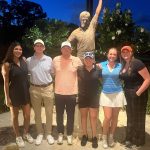What Makes Pinehurst Special: The Golfing Mecca in the Carolina Sandhills
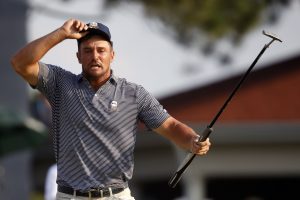
By Chandler Hawkes, Sports@CJC
PINEHURST, N.C. — For this year’s U.S. Open winner, Bryson DeChambeau, Pinehurst No. 2 holds a special place in his heart.
For DeChambeau, the iconic course located in the Sandhills of North Carolina represents one of his idols Payne Stewart, who won the 1999 U.S. Open at Pinehurst No. 2 with an iconic 15-foot par putt on the 72nd hole. Stewart, 42, tragically died in a plane crash just four months after his victory.
Twenty-five years later, the U.S. Open returned to the pine tree-lined fairways for the fourth time (joining ’99, 2005 and 2014).
To honor Stewart, who like DeChambeau played collegiate golf at Southern Methodist in Dallas, Texas, the final-round pin location was the same as it was in 1999, while a silhouette of his renowned fist-pump celebration with his leg kicked back was featured on the flag. DeChambeau won the 2024 U.S. Open on the 72nd hole and created his own iconic memory.
“I wanted to get this one done, especially at such a special place that means so much to me, SMU, my dad, what Payne meant to him, the 1000th USGA championship,” DeChambeau said.
Pinehurst is legendary to almost everyone in the golfing world for different reasons.
And every so often, the world’s best golfers, professional and amateur, flock here for the U.S. Open, which is played at the most famous of the now 10 Pinehurst courses, No. 2.
“Pinehurst is a special place,” said former Gators golfer Billy Horschel, a PGA Tour veteran who has played in 12 career U.S. Opens. “It’s like the home of golf for the U.S., in comparison to the St. Andrews home of golf. The courses are beautiful; the terrain is ideal for designing golf courses.
“Everyone, I think, enjoys it when they come here.”
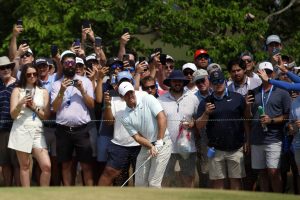
Even international golfers understand what Pinehurst represents and why it is significant.
Playing in his first U.S. Open and his second major championship, England’s Brandon Robinson-Thompson entered the tournament already with an outlook and perception of Pinehurst being a magical place for golf in America.
“Pinehurst seems to be almost a mecca of golf,” Robinson-Thompson said. “It’s a place where golf is everything, and I think it’s a place that all golfers should come and visit, whether it’s to watch the U.S. Open or to play any one of the amazing courses there is here.”
No. 2 represents one of golf’s greatest challenges, in the form of a U.S. Open golf course under the traditional conditions people associate with that tournament. A difficult golf course is expected, and patience is required. It is a golf course where pars are almost celebrated, while bogeys are withstood.
“There are about 18 of those [holes] where you just have to put your head down and [making] par is a great score,” Robinson-Thompson jokes. “There aren’t really any gimmes, just because you have to hit great shots pretty much on every hole. And even if you do hit good shots, sometimes they aren’t rewarded out here like other courses.
“You can’t really take any hole off, any shot off to be honest, which I think makes this a really unique test of golf.”
Taking holes off and shots off can and will result in a big score that can upend an entire round with just one swing.
Luke Clanton, who plays collegiately at Florida State, shot a 6-over-par 76 in his first major championship round, his first time playing Pinehurst No. 2 in U.S. Open conditions. He bounced back in his second round with a 1-under 69, which got him just inside the cutline. Following his first round, he learned that you can’t attack this golf course when the opportunity isn’t present.
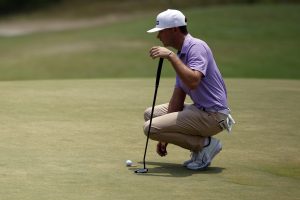
“Just don’t be an idiot,” Clanton said. “I think I was kind of an idiot on a couple of holes [in the first round], and it kinda screwed me.”
The golf course has changed since the first Open was held there in 1999. What once used to be a semi-conventional golf course with fairways, rough, bunkers, and greens has since become a unique golfing experience. The rough has been phased out and turned into what’s called a “native area.”
The native area is a melting pot of sand, grasses, plants and bushes, creating unique and unpredictable challenges for golfers.
“I think if you hit it in the rough enough out here, the rough is the sand and the bushes, you’re going to get some bad breaks. You’re going to get some good breaks,” said Tony Finau, who was playing his ninth U.S. Open. “I guess it might play in your favor if you only hit it in a couple of times like I did today. Fortunately, I had a lie to get it up on the green. Most of the time when you’re hitting out of the rough, you’re probably not going to hit the rough. So, I guess maybe your chances are a little higher here of having a shot.”
This idea of a 50/50 coin flip on whether you will draw a decent lie hitting into the native areas was shown to be proven in the final round of this year’s U.S. Open.
DeChambeau hit just five fairways in his final round, in which he shot a 1-over-par round of 71. Despite constantly missing the fairway, DeChambeau got his fair share of cleaner lies and could advance to the ball and not be harshly penalized for it.
Aside from the challenge, Pinehurst No. 2 can be seen as a measuring stick for anyone in the game of golf. It asks questions about your mentality as a golfer, and it points out strengths and weaknesses that you can’t hide.
Parker Bell, a rising junior on the UF men’s golf team, learned that throughout his first two career U.S. Open rounds. Bell made it into the field as a qualifying amateur, coming off a strong season with the Gators in which the team advanced once again to the national championships. Bell’s game was in a good spot coming in, he said, and he was excited to see how he could compete against the world’s best.
After two rounds around No. 2 and missing the cut, Bell walked away with his head held high as well as a list of things he needs to improve on that the course helped him realize.
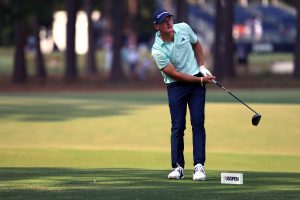
“I think I have what it takes to play out here; I just think the difference is they are way better around the greens,” Bell said. “They just don’t throw away a lot of shots. The bogey on 10 and 11, the guys who are competing to win this thing, they are not doing that. Yesterday, I made some really bad bogeys with wedges in hand…the best of the best just aren’t doing that. When I look back, I feel like if I was really sharp in every area I could be, then I could be easily inside the cutline.”
Outside of the history that comes with the land, the challenge the golf course presents, and the real-time dissection of your golf game that it can do, for some, Pinehurst represents a feeling of home and family.
Longtime PGA Tour professional and winner of the Players Championship, Webb Simpson, grew up in Raleigh, North Carolina, and his dad built a house in Pinehurst. Simpson is no stranger to the area and still spends considerable time here with his family, he said.
Some of his fondest golf memories have occurred right here with his dad.
“I never won the Putter Boy Trophy, so I never won the Donald Ross Junior or the North/South Junior or North/South [Amateur],” Simpson said. “My father and I, we won the Donald Ross Father-Son one day.
“It was alternate shot. We were in a playoff. In the playoff, my dad drove it in the fairway, I hit it to 3 feet, and then he made it for us to win. I was so excited. He looked at me like he was mad at me. I’m like, what? We just won. He’s like, ‘Don’t ever do that to me again. Hit it to 20 feet. Don’t hit it to 3 feet.’ We finally won.”
Pinehurst and Pinehurst No. 2 mean so many different things to so many different people in the world of golf. It is a place full of tests for golfers and is filled with stories and memories from those who have been.
As a place that holds so much history and represents so many different things, Pinehurst should be on every golf fan’s bucket list.
Category: Covering the U.S. Open
Tagged: 2024 U.S. Open Covering the U.S. Open
Subscribe to our News Digest

